A Guide to Gem Classification
Gemologists use several different gem classification methods. Learn how the most common systems work and what they cover as well as exceptions to the rules.
By Donald Clark, CSM IMG
Little is simple and straightforward in gemology. Every established principle has an exception. This applies to gem classification as well. There isn’t one way to classify gemstones. Rather, there are several. Each has its own purpose as well as exceptions that warrant close attention.

[*Thai ruby (3.66 cts) and Sri Lankan sapphire (2.75 cts). Photo © Joel E. Arem, PhD, FGA. Used with permission.]
Precious and Semiprecious Gems
For centuries, people have used the terms “precious” and “semiprecious” to describe gemstones. You’ll still occasionally hear these terms today. However, this gem classification has so many exceptions it has no real value. For example, diamonds have traditionally been considered precious gems, yet some sell for $100 a carat. You can see them (with sufficient magnification) as accent stones on inexpensive jewelry. On the other hand, garnet gems have traditionally been considered semiprecious gems, yet some sell in excess of $1,000 a carat, ten times the price of a low-quality diamond.
Referring to a set of gem types as “precious” and all other gems as “semiprecious” can be misleading, since it implies precious stones have inherently greater value. Professional gemologists no longer use these terms. If you encounter these descriptions, buyer beware.
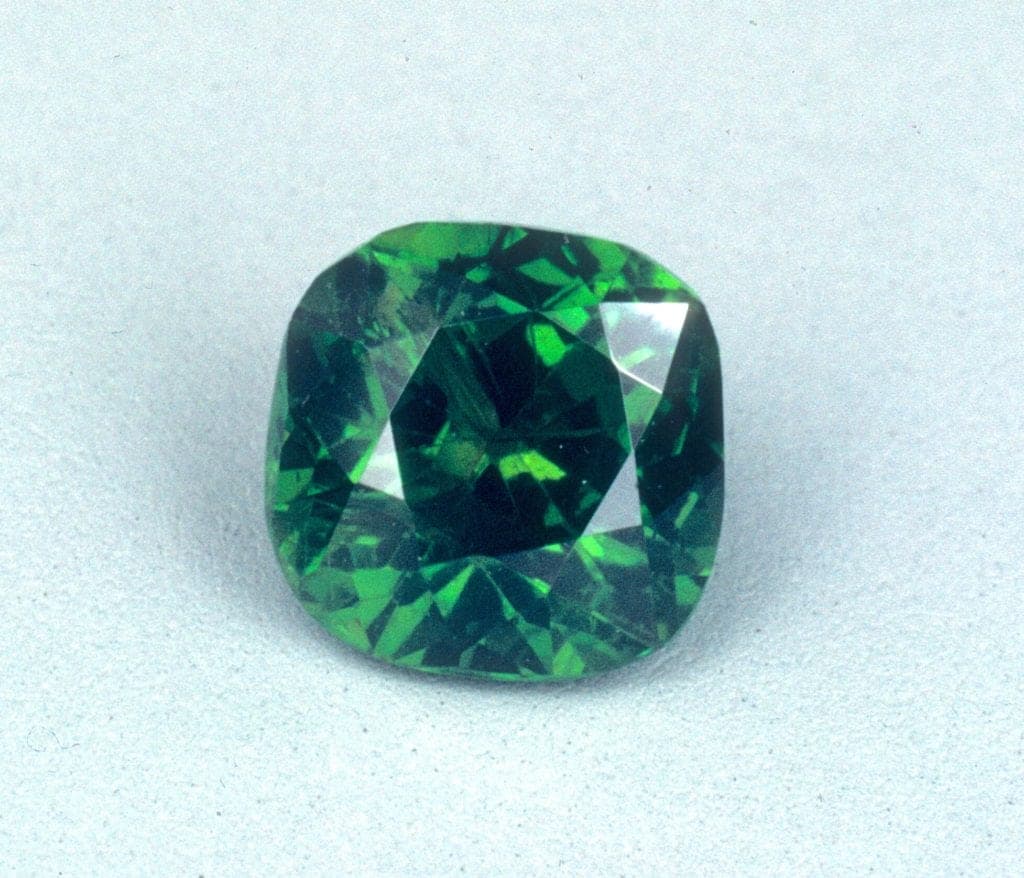
[*Named after diamonds because of their exceptional brilliance and dispersion, demantoid garnets rank among the rarest gems in the world and can command prices far higher than most diamonds. 1.1-ct demantoid, Russia. Photo © Joel E. Arem, PhD, FGA. Used with permission.]
Diamonds and Colored Stones
You’ll also commonly find gems divided into two other categories: diamonds and colored stones. (Some dealers use the shorthand “color” for colored stones). All gems other than diamonds fall into the “colored stones” category. Gem cutters and dealers use this gem classification system for two main reasons.
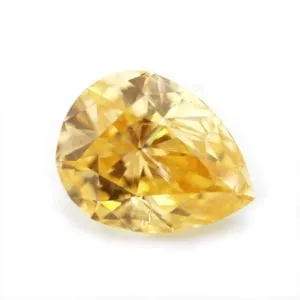
[*An orange-yellow diamond]
First, cutting diamonds requires special tools because these gems are harder than all others. With few exceptions, these tools aren’t suitable for cutting colored stones. Therefore, gem cutters need two different sets of tools for handling both types of stones.
Second, diamonds and colored stones are mined and distributed differently. Diamonds are one of the few gemstones with a consistent supply. Nevertheless, the diamond industry leads the general public to believe diamonds are incredibly rare. In fact, there are colored gems far rarer than diamonds.
Why does this happen? A near monopoly controls diamond sales and marketing. Those in charge are careful not to flood the market. Thus, diamonds maintain their value. Meanwhile, excellent advertising has also convinced the public that diamonds are the premier gemstones for engagement rings.
In this gem classification system, all diamonds, whether colorless or colored, are still considered diamonds. Nevertheless, colorless diamonds and fancy colored diamonds — those that show any color other than light yellow — have different grading systems.
Likewise, all colored stones are considered colored stones, even if a specimen is colorless. For example, gemologists would still classify a colorless sapphire or topaz as a colored stone. Unlike diamonds, however, a colorless specimen is graded the same way as a colored specimen.
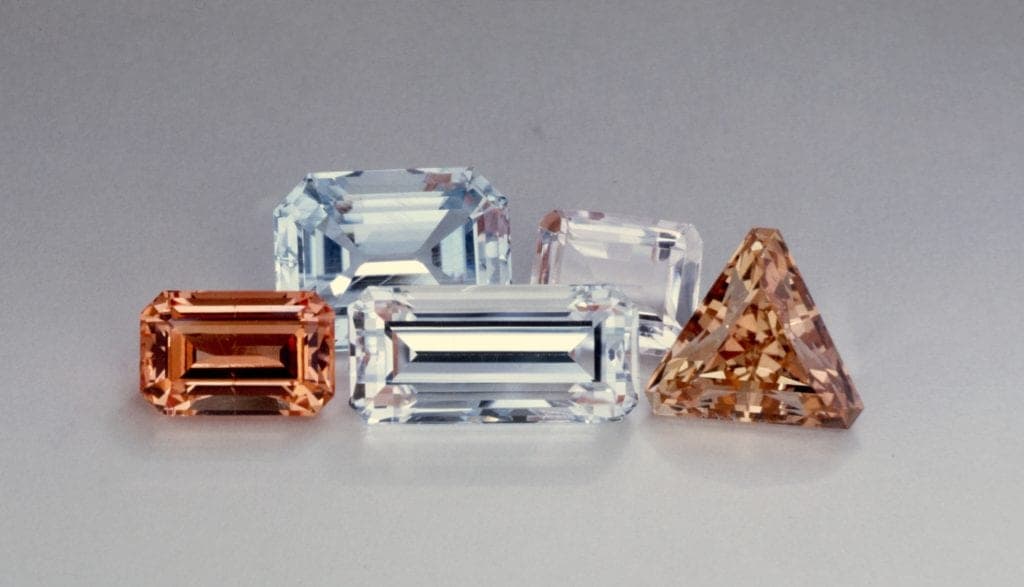
[*Brazilian topazes, including colorless specimens. Photo © Joel E. Arem, PhD, FGA. Used with permission.]
Natural, Synthetic, and Imitation Gems
Another way to classify gems is as natural or synthetic.
What’s the Difference Between Natural and Synthetic Gems?
Natural stones, of course, form in nature. Synthetic stones are grown in laboratories.
Natural and synthetic materials can share the same properties yet still have considerable differences. The main difference is rarity. A natural gem usually takes millions of years to form. Plus, many people feel natural stones have aesthetic qualities not found in mass-produced materials. Value is another difference. Since natural gemstones are rarer and take longer to form, they’re more valuable than their synthetic counterparts. For this reason, distinguishing between naturals and synthetics is an essential skill for gemologists.
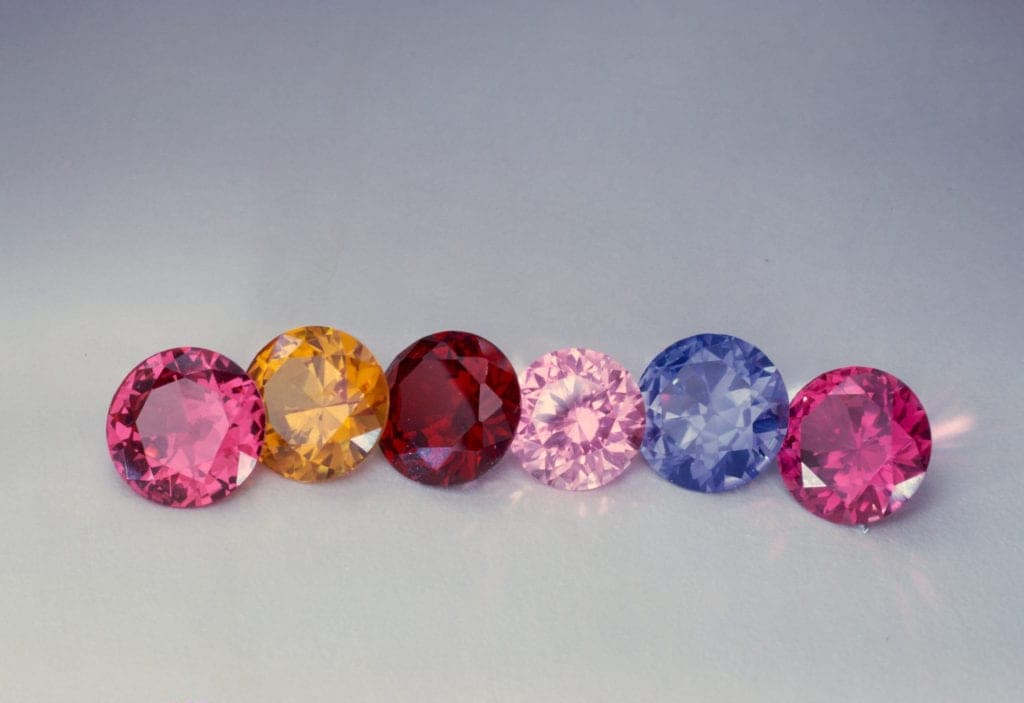
[*Synthetic corundum gems (rubies and sapphires). Photo © Joel E. Arem, PhD, FGA. Used with permission.]
What’s the Difference Between Synthetic and Homocreate Gems?
Stones created in labs can be subdivided further.
Synthetic refers to materials that duplicate their natural counterparts. For example, synthetic emeralds, sapphires, and spinels share the physical and optical properties of the natural varieties. In many cases, distinguishing natural and synthetic stones is quite challenging.
Homocreate materials have no natural counterparts. This category includes the lab-created gadolinium gallium garnet (GGG) and yttrium aluminium garnet (YAG).
For a long time, gemologists considered cubic zirconia (CZ) a homocreate gemstone. However, tiny CZ crystals not large enough to be used as gems have been found in nature as the mineral baddeleyite. This discovery means CZ is a synthetic stone rather than a homocreate.
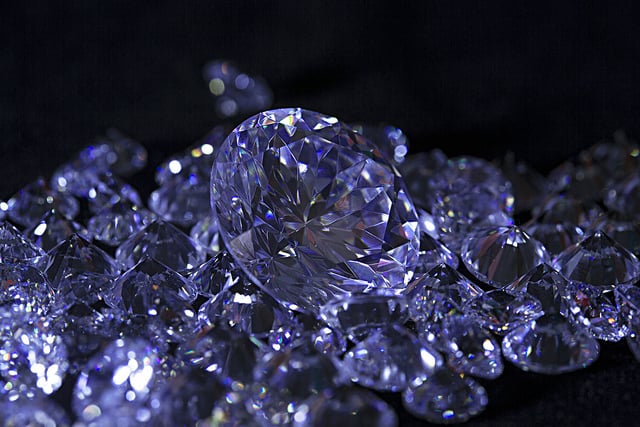
[*Manufacturers can create cubic zirconia as colorless stones or in a variety of colors, like these blue specimens. Photo by Jack Spades. Licensed under CC By 2.0.]
What are Imitation Gems?
A simulant or imitation gem is any material presented as a “lookalike” for another gemstone. For example, a natural white topaz can be sold as an imitation diamond. On the other hand, it can also be sold as a real topaz. A CZ described as a cubic zirconia in a jewelry ad isn’t an imitation. In contrast, a CZ represented as a diamond “lookalike” is an imitation.
Many vendors frequently sell imitation gemstones, typically for far less than the gems they imitate would cost. As long as consumers are aware they’re purchasing “fake pearls” or “fake diamonds,” for example, there’s nothing unethical about this. However, selling an imitation gem as the real thing is unethical.
Organic and Inorganic Gems
Another approach to gem classification is to separate gems into organics and inorganics. Organics refer to gems whose formation involves living organisms. Amber, for example, began as tree sap. Various mollusks create pearls. Hence, these gem materials are classified as organic.

[*This pendant features an amber gem containing fragments of fossilized organic matter.]
The term inorganic covers everything else. So, everything in the mineral world falls into the inorganic classification.
However, not all inorganic gems are minerals. In the United States, a gemstone can only be classified as a mineral if it was created geologically in the Earth. Thus, lab-created stones, even though they have inorganic origins and the same properties as their natural counterparts, can’t legally be described as minerals. For gem classification purposes, these lab-created gems have the same properties as their natural mineral counterparts. However, advertisements can’t describe them as minerals.
Crystalline and Amorphous Materials
Differentiating between crystalline and amorphous materials is another way to classify gems. The term “crystalline” refers to minerals comprised of a repeating arrangement of atoms. The term “amorphous” refers to materials that don’t consist of a repeating arrangement of atoms. Although some materials may look like crystals to the naked eye, only their atomic structure matters when making this distinction. For example, a glass cube may look like a crystal, but its atomic structure remains non-crystalline. Glass, both natural and manufactured, is an amorphous material.
Not all gems are crystalline. Amber and opal as well as glass are good examples of amorphous gem materials. Amorphous materials can have either organic or inorganic origins. Examples of organic amorphous materials include amber and ivory. Inorganic amorphous gems include opal.

[*Ivory jewelry. Photo © Joel E. Arem, PhD, FGA. Used with permission.]
Aggregates
The term “aggregate” applies to groups of small gems that form together. Aggregates form when the requirements needed for gem formation — such as certain chemicals, heat, pressure, and space — aren’t present for the necessary amount of time.
Although an aggregate may look amorphous, it consists internally of thousands of microscopic crystals. The most common example of aggregate minerals is the chalcedony family, which includes agate and jasper. These members of the quartz family share many common characteristics. So, these aggregates may have the same specific gravity and refractive index as a whole crystal of quartz but very different appearances.
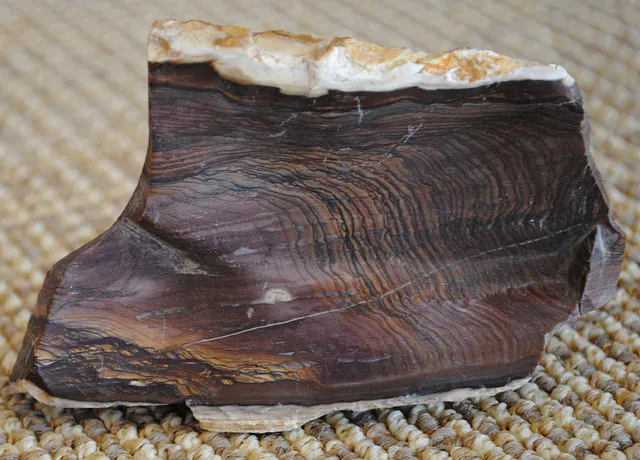
[*Biggs jasper. Photo by Deidre Woollard. Licensed under CC By 2.0.]
Rocks
Whereas crystals and amorphous materials have a single main ingredient, a mix of minerals comprise rocks. While not a gem material, granite is one of the most common and best known rocks. If you look carefully at a sample, you’ll see black, white, and gray bits all bound together. You won’t see too many rocks in gemology. Lapis lazuli is perhaps the most well-known rock commonly encountered in the gem world.

Minerals and Gem Classification
Now we’re getting into the heart of gem classification. The vast majority of gems are minerals. Both chemical makeup and molecular structure define the mineral species.
Chemical Makeup
Chemical makeup” refers to the atoms contained within the mineral. Diamond, for example, has the simplest chemical makeup. Carbon (C) is the only element present. Corundum is composed of just two elements, aluminum (Al) and oxygen (O), expressed as the formula Al2O3. This means a molecule of corundum contains two aluminum atoms and three oxygen atoms.
The chemistry of other gems gets more complicated. For example, tourmaline”s chemistry can be expressed as Na(Li,Al)3Al6B3Si6O27(OH)3(OH,F).
Molecular Structure
“Molecular structure” refers to how molecules attach to each other. While you can”t see individual atoms, you can see the results of how they attach to each other in whole crystals. Diamonds form crystals that look like two pyramids attached at their bases. Quartz forms elongated crystals with six sides. These are results of their molecular structures. For example, imagine you have two sets of tiles. The four-sided tiles will form one kind of design. The six-sided tiles will form an entirely different set of designs. The two styles can”t fit together. Each set makes up a different crystal system.
Example: Diamond and Graphite
Used in pencil leads, graphite is very soft and black. The hardest substance in nature, diamond is (usually) colorless. Graphite and diamond both have the same chemical makeup: pure carbon. So, what accounts for the difference in appearance and hardness? Their different arrangements of carbon atoms. The carbon atoms in diamonds are arranged in a tetrahedral pattern, where each carbon atom is bonded to four other carbon atoms. This structure is incredibly stable, which accounts for a diamond’s hardness. On the other hand, the carbon atoms in graphite are arranged in a “chicken wire” pattern. This structure is less stable. This makes graphite soft.
When minerals share a chemical makeup but have different molecular structures, their molecular structures define the mineral type. Some minerals share a molecular structure but have different chemistry. In these cases, the chemical makeups define the mineral type.
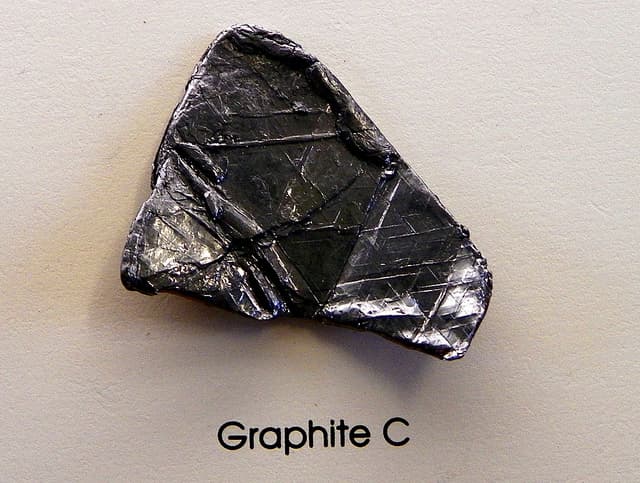
[*Graphite specimen on display at the Natural History Museum, London. Photo by Peter O’Connor aka anemoneprojectors. Licensed under CC By-SA 2.0.]
Mineral Species and Varieties
Throughout this article, we’ve discussed pure minerals. In nature, minerals commonly have impurities present in very tiny amounts, usually 3% or less of the crystal by weight. These impurities don’t change the primary chemistry. Therefore, the mineral name, or species, doesn’t change. They do, however, change some of the mineral”s characteristics, so we use a sub-classification called a variety.” Changes in characteristics such as color can have a considerable effect on a gem mineral’s value.
Colors and Varieties
Many pure minerals are colorless. Impurities give them color. For example, pure corundum is colorless. Add a bit of chromium and we call it a ruby. Add a bit of titanium and iron and we have a blue sapphire. Pure beryl is also colorless. Add a touch of chromium and we have an emerald. Add a bit of iron and you get an aquamarine. Just a tiny amount of impurities can make a mineral exceptionally valuable!
Corundum and beryl are called “mineral species. Their colored versions are “varieties.” Another very common species is quartz, with colored varieties such as amethyst, citrine, and smoky quartz.

[*Quartz varieties: rock crystal (colorless, 11 cts), prasiolite (green, 4.48 cts), and rose quartz (pink, 14.20 cts). Photo © Joel E. Arem, PhD, FGA. Used with permission.]
Garnet Exceptions
There’s always an exception or two. So, here we go. Not all minerals are colorless in their pure state. Garnet is one of the most obvious examples. Furthermore, there are several species of garnets as well as varieties. Garnets all share the same structure and a lot of similarities in their chemical makeup. However, they do have variations in chemistry. Each of these variations equals a new species of garnet.
Here’s an illustration that’s not quite scientifically accurate but still helps explain how garnets vary. Look at your hand and pretend it’s a model of a garnet molecule. All garnets have the same structure, the shape of your hand, and pretty much the same chemistry. The last joints of your fingers represent separate atoms. While most of the atoms remain the same, different atoms can reside in those joints. If you change the atoms (the chemistry), you change the species. That”s the rule. However, you can see that the shape of your hand has no’t changed nor have any of the other basic characteristics. Hence, the different species are still garnets.
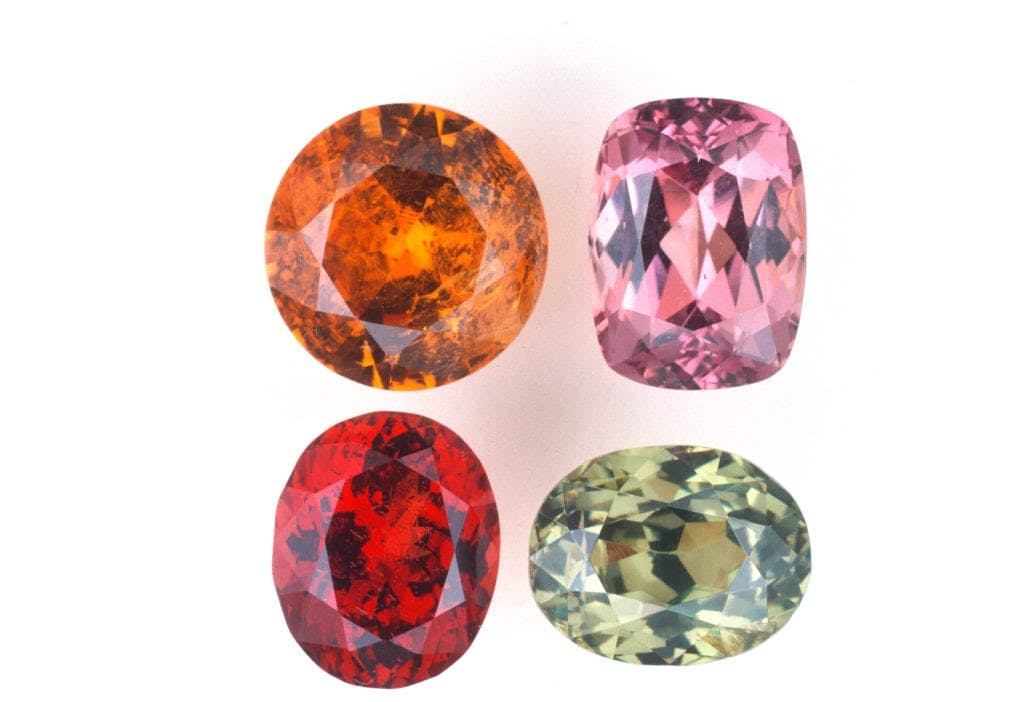
[*Garnets. Photo © Joel E. Arem, PhD, FGA. Used with permission.]
Series and Blends
Common red garnets are either almandine or pyrope garnets. Both of these garnet species are deep red. However, each has a slightly different chemical makeup. The purest almandine garnet ever found contains about 20% pyrope. The purest pyrope also contains about 20% almandine. Each of these gems also contains a minute amount of other garnet species. When gemologists need to name a garnet, they call it by the majority component. As you can see, this isn’t always a clear distinction. Consider this: if the purest pyrope garnet ever found is only 80% pyrope, then there are a lot more specimens that are closer to being only 50% pyrope. Gemologists describe most garnets simply as an almandine-pyrope blend.
Some garnet blends take on a distinct set of characteristics. For example, a rhodolite is approximately 70% pyrope and 30% almandine. What makes it distinctive is its purple coloring, since its two major components are red. This quality is distinct enough that rhodolite is considered a variety of garnet.
Garnets never occur in their pure state but always in combinations with each other. For example, most gem-grade garnets are in the almandine-pyrope-spessartite series. Almandine, pyrope, and spessartite are individual species of garnet and are always found together. The species that makes up the majority gives its name to the gem. This kind of blend, where species of a specific gem are always found together, is called a solid-state series.
Do Other Minerals Form Series?
Garnets aren’t the only minerals that form series. Feldspars and spinels also form in a solid-state series like garnets.
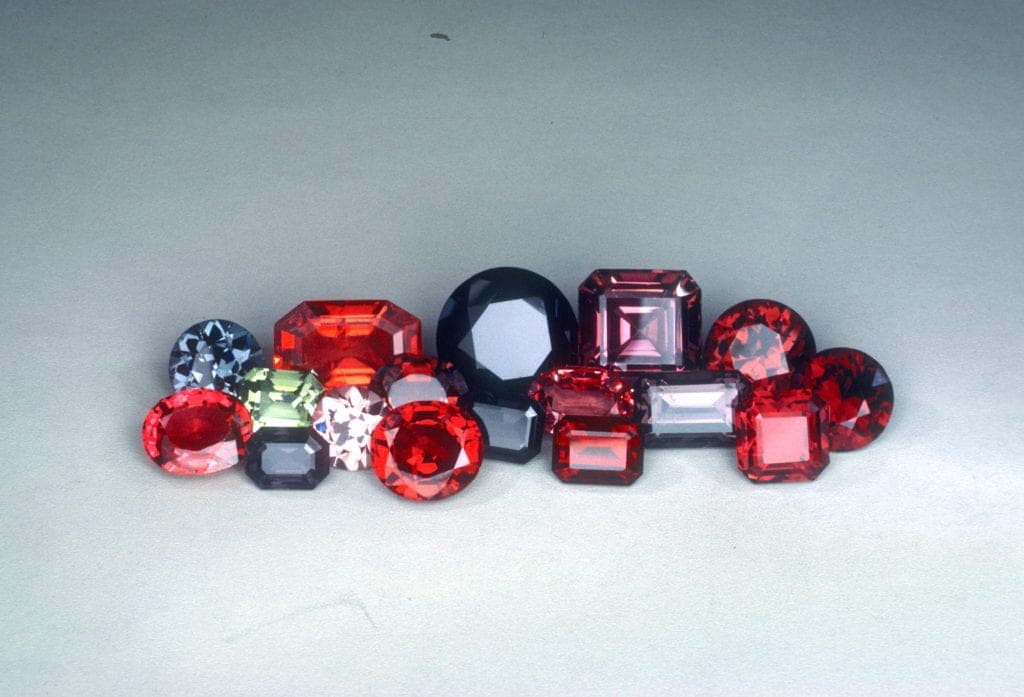
[*Spinel color suite (gems from 1 to 15 cts). Photo © Joel E. Arem, PhD, FGA. Used with permission.]
Mineral Groups and Gem Classification
Scientists also class minerals into groups. Although more important to mineralogists than gemologists, learn the terminology. The fields overlap and the terms appear occasionally in gemological texts.
Not all species in a group may be considered gem-quality materials. For example, faceters usually only cut the three garnet species previously mentioned, plus andradite, grossular, hydrogrossular, and uvarovite (as well as their blends and varieties). Non-gem quality garnets include goldmanite, kimzeyite, knorringite, schorlomite, and yamatoite.
A similar situation exists for the tourmaline and feldspar groups. Only a few of their members typically find use as gems.
Mineral Classes and Gem Classification
Shared chemistry can also categorize minerals. For example, all minerals that contain silica are grouped as silicates. Although not important to all gemologists, gem cutters may find this information useful. For example, when lapidaries are cutting a gem for the first time, they must determine the best polishing compound. Identifying the class of the gem makes it reasonable to start with compounds that work for other gems in that grouping.